Characteristics of typical 50 liter gas cylinders: design, dimensions and weight of the cylinder
Agree that every summer resident or resident of a country house has at least once encountered power outages.And when there is no electricity and a main gas pipeline, it is impossible to cook food and heat a residential building.
Therefore, in regions and villages where there is no gas pipeline or frequent power outages, gas cylinders are considered a real salvation.
For those who often use gas containers, it is important how many cubic meters of gas are in a 50-liter cylinder, because this characteristic allows you to calculate the time and amount of work that can be done using one cylinder. We analyzed the regulations governing the design and rules for filling standard 50-liter gas cylinders. Therefore, after reading the information below, you will decide whether or not to use a vessel with such an impressive volume.
The content of the article:
Steel gas cylinder design
For transportation and storage of light hydrocarbons such as propane, propane-butane or butane, can be used composite cylinders, with a capacity of up to 47 liters.
However, more capacious, 50 liter vessels for liquefied hydrocarbons are made of steel. To store other liquefied or compressed gases, only steel tanks of various capacities are used.
IN GOST 15860 The types, characteristics and permissible sizes of gas cylinders for hydrocarbons are described in detail. IN GOST 949-73 the parameters of gas tanks suitable for operation, with internal pressure up to 19.6 MPa, are indicated.
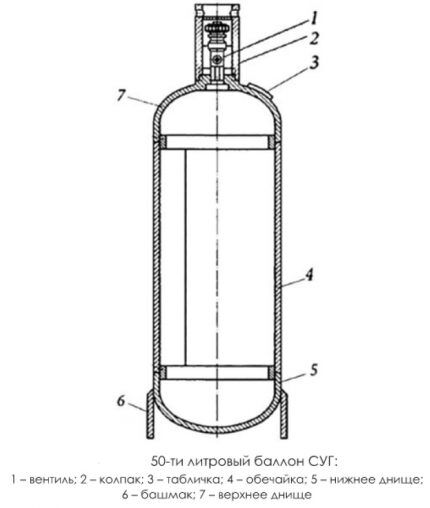
Both GOSTs indicate that for safe transportation and storage of gases, each vessel must have the following structural elements:
- Support shoe.
- A body consisting of a shell, lower and upper bottom and a backing ring.
- Information plate.
- Neck.
- Valve or tap.
Modifications are allowed that include a collar, handle/handles and a cap.
In addition to the basic standards for the manufacture of gas cylinders, there are additional standards that manufacturers must comply with.
Supporting documentation includes safety rules: PB 03-576-03 “Rules for the design and safe use of pressure vessels”. They describe in detail the requirements for valves and other auxiliary mechanisms.
Dimensions and weight of 50 liter vessels
To determine how much an empty 50-liter gas cylinder weighs, you need to know the wall thickness and dimensions of the tank.
Since the production of gas cylinders is possible only in compliance with certain standards, all the necessary characteristics are already contained in them. According to GOST 15860, the metal thickness for a 50-liter gas cylinder intended for storing light hydrocarbons is 3 mm.
The standard diameter of a 50 liter cylinder in which propane or butane is transported is 299 mm. And the height of its body can vary from 840 to 1015 mm.
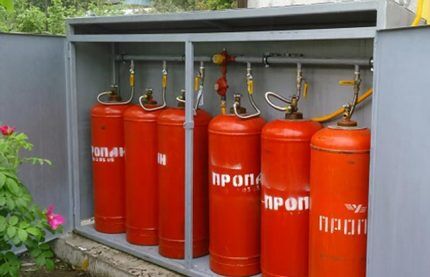
The standards for the manufacture of gas cylinders indicate that the steel thickness can be 2.5 mm. In this case, the manufacturer must reduce the diameter of the vessel to 292 mm and increase its height. The minimum height in this case starts at 876 mm.
Thus, the diameter of a standard 50 liter cylinder is 29.9 cm, and the height is 93 cm. At the same time, the mass of an unfilled, empty cylinder, taking into account typical shut-off valve equal to 22 kg. At correct filling of the cylinder with the required amount of gas, the weight will be set at 43.2.
Gas cylinder capacity
According to the operating rules, a 50 liter gas cylinder can be filled with 42.5 liters of liquefied gas. This volume of contents for a 50 liter gas cylinder is established by regulatory documentation, which states that for safety reasons, the container can be filled no more than 85%.
In addition, the contents of the vessel should not be completely consumed.
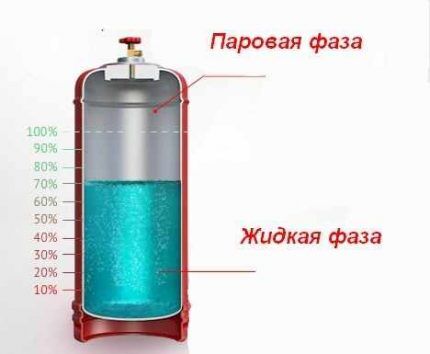
Let's try to calculate how many cubic meters of gas will be contained in a 50 liter cylinder. It is known that under standard conditions, 1 kg of LPG produces 0.526 cubic meters of propane or 0.392 cubic meters of butane. In this case, the percentage of the gas mixture is 60:40 (60% propane and 40% butane).
Let's calculate the volume of the propane-butane mixture, provided that the cylinder contains 21.2 kg of gas:
21.2 kg • (0.526 • 0.6 + 0.392 •0.4) = 10.01 m3
This means that a 50 liter cylinder contains approximately 10.01 cubic meters of gas.
How long will a gas cylinder last?
In order to determine how long a filled 50 liter propane cylinder will last, you will need to calculate how much gas a particular device will consume.
For example, your 4-burner stove has a gas consumption of 0.45 kg/hour (this information can be found in the technical documentation for the device). Next, divide the amount of gas in the cylinder by the flow rate: 21.5/0.45= 47.7. This means that if you turn on all 4 burners, the cylinder will last for about 47 hours.
Of course, all four burners will not work all the time, which means the cylinder will last for a longer period.
If you plan to use bottled gas for heating, then its consumption can be calculated in the same way as for gas stoves. For example, let's calculate how many days a 50-liter filled cylinder will last for heating a private house, if we know that the maximum gas consumption of a gas boiler is 1.5 kg/hour.
Before making calculations, it is worth considering that boilers operate on average for 10 hours. But, if the boiler is also supposed to be used for heating hot water, then gas consumption increases by almost 20%.
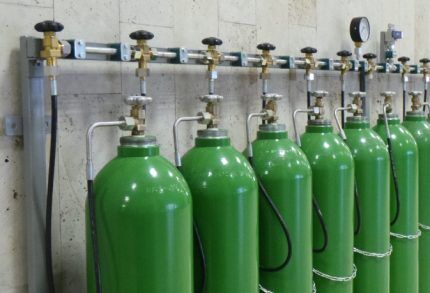
Divide the mass of gas in the cylinder (21.5 kg) by its consumption (1.5 kg/hour) and get 14.3 hours. Considering that a gas boiler does not operate around the clock, an LPG cylinder may last for a maximum of 2-3 days.
In addition, we should not forget that fuel consumption also depends on the degree insulation of your country house and average daily outside temperature.So, the less insulated the house is and the lower the ambient temperature, the more fuel the boiler will need to burn in order for the room to warm up to a comfortable temperature.
The calculations made indicate that a 50-liter cylinder is not enough for comfortable living in a country house, especially if both the boiler and the stove consume gas. Therefore, many owners of private cottages design a gas supply system based on 3-4 50-liter gas containers at once, which requires compliance with special conditions for their operation and storage.
What load can the container withstand?
Standard cylinders can withstand pressures up to 19.6 MPa. In this case, the wall thickness can reach up to 8.9 mm. However, not a single gas distribution or consuming device can withstand such a powerful pressure.
The standard pressure in a 50-liter container is always 1.6 MPa. This pressure indicator is optimal for the operation of all household appliances. gearboxes, to which stoves, heaters, ovens and boilers are connected.
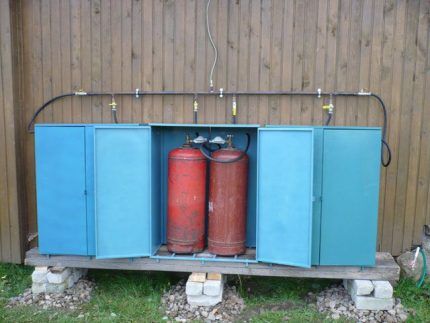
Manufacturers of standard containers focus on a pressure of 2.5 MPa, because the vessel must withstand it during inspection, once every five years. If the seams do not hold up, the flask is immediately scrapped.
The locking unit must also withstand a pressure of 2.5 MPa. Although its device allows you to control pressure up to 19.6 units.Cylinders are subjected to this test in exceptional cases; they are usually filled with gas with a pressure of 1.6 MPa.
Gas cylinder color
Rules PB 03-576-03 state that the outer surface of vessels intended for transporting gases must be painted in the appropriate color. It depends on the type of gas that will be filled.
For butane and other flammable gases, red cylinders are provided. Moreover, for some gases not only a color is provided, but also a corresponding color stripe.
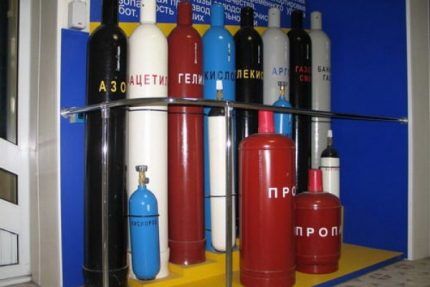
In addition, the standards establish an identifying inscription that should be applied to the vessel. The word “Butane” must be printed on the butane cylinder, and “Propane” on the propane cylinder. The text color of the inscription on a vessel with hydrocarbon gas is white. Read more about the types of gas cylinders Further.
Conclusions and useful video on the topic
How to make a box for storing gas containers from scrap materials in a country house:
This is how 50 liter propane cylinders are filled at filling stations:
Subject to simple but mandatory safety measures, a gas cylinder in construction, metallurgy, a private home or in a country house will become the most useful and indispensable thing.
Those who decide to use an individual gas supply system will have to solve many problems at the beginning of the design: what sizes of gas cylinders will be optimal - 27 or 50 liters, how many containers will be required for the constant operation of the system, as well as where and how to store them.And, if you calculate the input parameters correctly, the output will be the most perfect, uninterrupted household unit.
If you have ever used 50 liter gas containers, please share: are they convenient for transportation and use at your summer cottage? To add comments, use the form below. Ask questions to experts, share your experience and current photos.




Thank you for this informative and interesting article.
I managed to glean something useful from it for myself! My brother and I installed a boiler at the dacha and connected the cylinder. We'll be taking a second one soon, because... one is inconvenient to use.
Question: is it possible to place the cylinder in the same room (or adjacent) where the boiler is operating? For now, we have done this at our own peril and risk... please tell me, I will be grateful for your answer.
Hello. The answer to your question is not so simple.